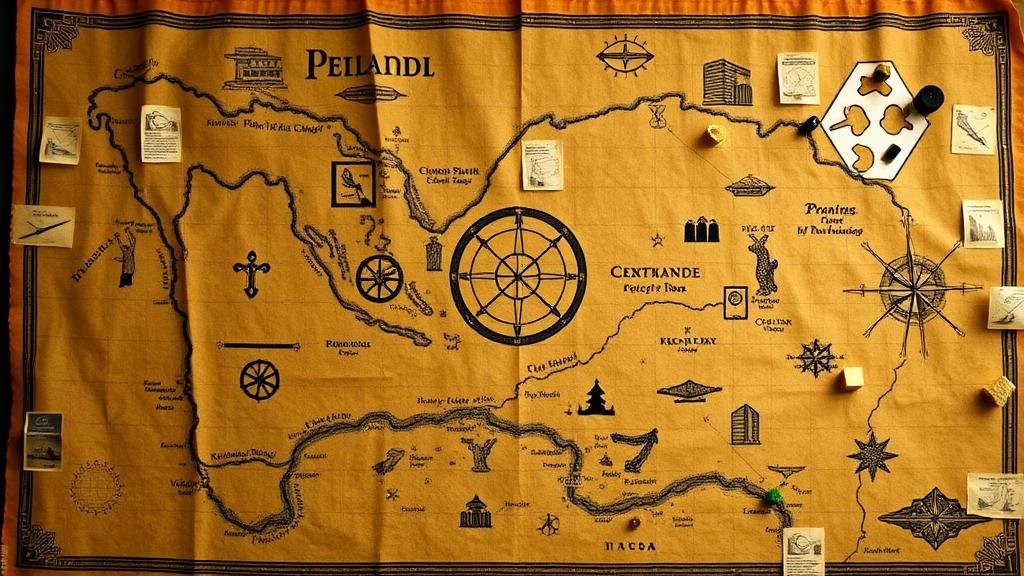Recognizing Disguised Treasure Symbols on Maps Hidden in Artworks
Recognizing Disguised Treasure Symbols on Maps Hidden in Artworks
The intersection of art and treasure hunting has fascinated historians, archaeologists, and enthusiasts alike for centuries. Within the realms of classic paintings and sculptures, there are often hidden meanings or symbols that can lead to real-world treasure. This article explores how to recognize disguised treasure symbols located on maps concealed within artworks, providing a structured guide to identify and interpret these clues effectively.
The Historical Context of Hidden Symbols
The tradition of embedding treasure maps within artworks dates back to ancient civilizations. For example, during the Renaissance, artists like Leonardo da Vinci were known to infuse their works with cryptic elements intended to convey deeper meanings or to hint at location-based treasures. This historical practice underscores the significance of understanding symbols in art.
One compelling example is the famed Voynich Manuscript, an illustrated codex from the early 15th century filled with mysterious symbols and maps. Art historians and cryptographers continue to study this manuscript, seeking to decode its messages, an endeavor that illustrates the allure and complexity of art as a medium for hidden knowledge.
Common Symbols and Their Meanings
Recognizing the symbols that might indicate hidden treasure requires familiarity with specific iconography prevalent in past artworks. Below are common symbols to consider when analyzing art for disguised treasure maps:
- Sailboat Imagery: Often indicates an aquatic route to treasure, especially in maritime-themed artwork.
- X Marks the Spot: A classic symbol indicating the precise location of buried treasure.
- Suggests guidance or directions towards a treasures whereabouts.
For example, the famous Map of the Gilded Age, a treasure map hidden in the artwork of painter Thomas Cole, denotes specific landmarks that lead to a historic treasure cache. By studying such maps, one can glean additional layers of meaning that may not be immediately apparent.
Analyzing Color and Composition
Artworks employ color and composition not merely for aesthetics but also as a functional means of conveying information. Specific colors can point towards particular meanings or contexts surrounding hidden treasures. Below are some essential aspects to consider:
- Red and Gold: Often symbolizes wealth, indicating proximity to buried treasures.
- Shaded Areas: Can suggest secretive zones, implying that further scrutiny may reveal obscured treasures.
For example, in Vincent van Goghs paintings, hues and contrasts often serve to highlight significant narrative elements, which could include concealed treasure indicators. Understanding these choices can provide vital clues for treasure hunting.
Employing Technological Tools for Detection
Modern advancements in technology allow for a more systematic approach to discovering hidden treasure symbols. The following tools can significantly enhance exploration:
- Digital Enhancements: Software enabling infrared imaging and multispectral analysis can reveal underlying layers of paint, often where maps and symbols may lie.
- GPS Technology: When hunting for physical treasures that are indicated by historical maps, the integration of GPS can streamline the search process.
An excellent case study illustrates the application of this technology: the work done on the Fleur-de-Lis tapestry, underwent spectral imaging that uncovered a hidden map leading to a cache of invaluable artifacts.
Real-World Applications of Treasure Map Analysis
Treasure hunting, while often seen as a pursuit of the adventurous, can also lend itself to academic study. Projects for determining the validity of hidden maps in artworks can lead to a wealth of historical knowledge. One notable project involved examining the paintings of Gustav Klimt, which resulted in the discovery of coded messages that outlined the locations of lost artworks from his collection.
Such studies reveal not only the treasures themselves but also the cultural and historical contexts surrounding these artworks, providing a richer understanding of the period in which they were created.
Actionable Takeaways
In summary, recognizing disguised treasure symbols on maps hidden in artworks is a multifaceted endeavor that combines art history, symbolism analysis, and modern technology. Here are several actionable steps for aspiring treasure hunters:
- Study historical contexts of the artwork to understand potential hidden meanings.
- Familiarize yourself with common symbols related to treasure maps.
- Use modern technological tools for deeper analysis of artworks.
- Create a systematic approach to document findings and develop search strategies based on discovered symbols.
Embarking on the quest for hidden treasures in art sensibly and thoroughly may not only lead to material wealth but can also enrich ones understanding of history and culture.


